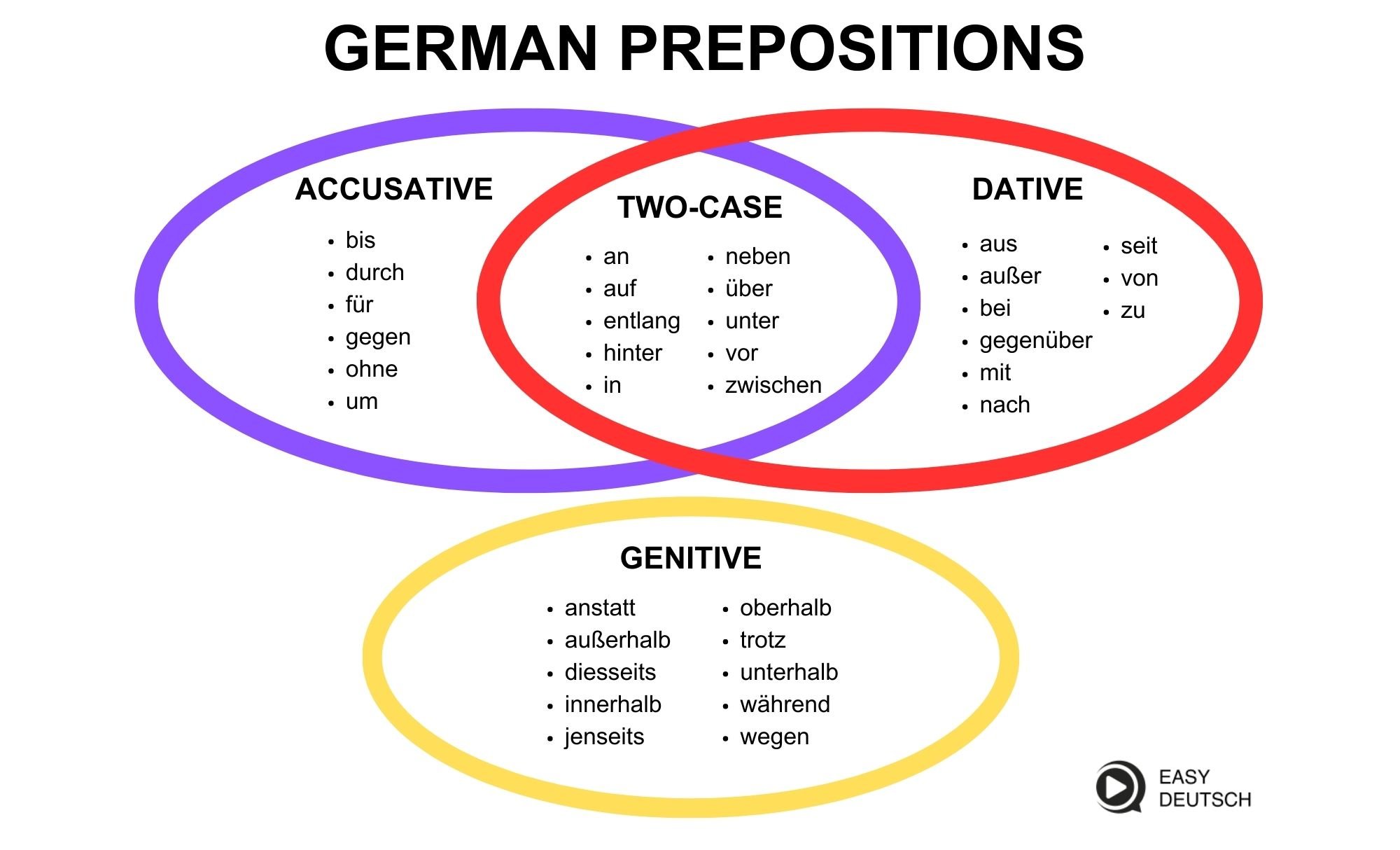Do you prefer to read this lesson 11 Secrets to German Cases in German? Switch language now!
German grammar, with its intricate cases, can often seem like a labyrinth to learners. Yet, cracking the code of German cases is essential for mastering the German language. In this post, we'll unveil the secret behind understanding the four German cases: Nominative, Accusative, Dative, and Genitive. Let's take a look at it! I promise you it's easier than you might think
German cases are like puzzle pieces that assemble a sentence into its proper form. These cases dictate how nouns, pronouns, and articles behave within German sentences, indicating their roles and relationships.
1. The Basics of German Cases
Imagine German cases as linguistic signposts. They guide you through sentences, pointing out who's doing the action, receiving it, or possessing something. The case endings are your guideposts that make sense of sentence structure. In English this is achieved mostly with the use of prepositions. You will see this in German as well, but German gives you an option without prepositions, which makes the language a way more flexible than English for example.
And YES, there is a real (and surprisingly simple) system behind the four German cases!
Nominative Case
The Nominative case introduces the subject of a sentence—the one performing the action. In "Der Hund bellt." (The dog barks.), "Der Hund" is in the Nominative case, performing the action of barking.
Accusative Case
When the subject of the action is the direct object, the Accusative case comes into play. For instance, in "Ich kaufe den Ball." (I buy the ball.), "den Ball" is in the Accusative case as it's the direct object - this means it's used to perform the action of "kaufen" (to buy).
Dative Case
The Dative case deals with the indirect object—think of it as the recipient of the action. In "Ich gebe dem Kind einen Apfel." (I give the child an apple.), "dem Kind" is in the Dative case as the recipient of the apple.
Genitive Case
The Genitive case showcases possession or association. In "Das ist das Auto meines Vaters." (That's my father's car.), "meines Vaters" demonstrates possession, revealing the car belongs to my father.
Interesting fact: Do you know why there is "'s" at the end of "my father's" car? - Yes English is using cases as well! But a way less than German does, so so English teachers won't explain it to you as Genitive case and rather tell you: Put "'s" there - do it and don't ask why! 🙂
2. Verbs & Preposition love German Cases
Beside the overall "meaning" of the cases that you just learned there are also verbs and prepositions dictating the case you have to use.
Some verbs like "helfen" require you to use dative case. A list of verbs with dative case (Verben mit Dativ) and Verbs with other cases you can find in my German Grammar List Section.
It's also very important to know, that absolutely every single preposition has it's own will and only works with certain cases!
Most prepositions are "loyal" to one of the cases only - means if you see them you know which case you have to use with the following articles, adjectives, nouns or pronouns - NO EXCEPTIONS!
But there are also prepositions that are less loyal. They are called Two-Way-Prepositions (Wechselpräpositionen) and depending on the situation they can work with two different cases (usually Accusative or Dative).
3. Tips for Navigating Cases
Tip 1:
Prepositions are the Kings if it comes to German cases. If the preposition dictates a certain case it doesn't matter what the verb wants or if it's the direct or indirect object - The preposition tells you which case it is! ALWAYS - NO EXCEPTIONS!!
Tip 2:
If there is no preposition check if the verb requires a certain case and only after you have checked that check for direct and indirect object, as well as possession (Genitive)
Tip 3:
Use color coding! Did you notice that I have put the four different cases in four different colors? If your brain associates a case with a certain color, it will become a way easier to remember which case to use. Therefor, write prepositions and verbs that require a certain case in different colors.

That's how your vocabulary list should look like!
4. Adjective Endings and Cases
Adjective endings shift based on case, gender, and number. They harmonize with the noun they describe, aligning with the case required.
If you want to know more about it check out my blog post about "How to avoid mistakes with German Adjective Endings" or the detailed explanation about Adjective Declension (Adjektivdeklination)
5. Practice German Cases
- The cat is sitting on the table. - auf dem Tisch. - auf = Wechselpräposition - Location = Dative
- I am reading a book. - ein Buch. (direct Object = Accusative)
- She gives the gift das Geschenk to a friend einem Freund. - direct and indirect object
- The students are playing in teh apartment. - in der Wohnung. - in = Wechselpräposition - Location = Dative
- He goes for one hour into the store. - für eine Stunde. - für - always Accusative // in den Laden - in = Wechselpräposition - Movement from A to B = Accusative
- They are coming to our home. - zu unserem Haus.- zu - always Dative
- She is talking with her parents. - mit ihren Eltern. - mit - always Dative
- He sees the dog in the the garden. - den Hund (direct Object = Accusative) // in dem Garten - in = Wechselpräposition - Location = Dative
- We have a party at the vacation home of my parents. - eine Party (direct Object = Accusative) // in der Ferienwohnung - in = Wechselpräposition - Location = Dative // meiner Eltern - Owners of the vacation home = Possession = Genitive
- They walk through the tunnel. - durch den Tunnel. - durch - always Accusative
*All translations are word by word to help you to understand German Sentence Structure
** All sentences start with the subject in Nominative Case - It's the most obvious and easiest case. In German you don't have to start the sentence with the subject, but to make this less confusing we did so.
6. Using Cases in Conversations
As you advance, apply cases in real conversations. For instance, "Ich kaufe dem Mädchen Blumen." (I'm buying flowers for the girl.) reveals Dative case's role in indicating the recipient. But don´t get to paranoid about it - people will probably still get it, even if you get the cases wrong. They might have to think a second what you mean, or simply ask if they can´t figure it out.

The Most Important:
Don't be discouraged from speaking. Making mistakes is part of the progress! It's part of language learning! And how much do you care if somebody makes a mistake in your native language, but you are still able to understand him or her? I bet you don't care at all! That's exactly how much other people care about you making a mistake!
The best way to learn German Cases and any language is to speak it, to practice it. Trying to get rid of all errors is just for your personal confidence and self-esteem!
So start speaking!
7.Common Questions and FAQs
Q1: Can I ignore cases and still be understood?
While simpler sentences might be understood, mastering cases enhances your fluency and prevents misunderstandings.
Q2: How can I remember all these endings?
Practice is key. The more you apply cases in speaking and writing, the more intuitive they become.
8. Conclusion
German cases are the threads that weave sentences together. Embrace them as the essential tools that add depth and precision to your language mastery. With diligent practice and a grasp of these cases, you're on your way to master German language and German Grammar.








